Every click, query, and conversation your customer has with your business tells a story. The real question is, are you truly listening?
In today’s data-driven world, businesses are overwhelmed with information, yet much of it remains untapped. Every interaction whether a purchase, a support call, or a social media comment, holds critical insights into what your customers need and how your business can evolve. However, these insights often remain fragmented and disconnected.
Traditional analytics tools offer a glimpse into the past but fail to provide the real-time intelligence needed to stay ahead. This lack of connection means businesses misses opportunities to predict behavior, personalize experiences, and make swift, informed decisions.
This is where customer intelligence analytics steps in. It transforms fragmented data into a 360-degree, real-time understanding of your customers. By integrating data across various touchpoints, businesses can anticipate needs, personalize experiences, and build stronger, more loyal relationships. But how exactly does it work, and why is it more crucial than ever?
In this blog, we’ll explore how customer intelligence analytics turns raw data into actionable insights, enabling businesses to forge deeper customer connections and drive sustainable growth.
Customer intelligence analytics: Beyond traditional analytics
Customer intelligence analytics unifies fragmented data into a real-time, comprehensive view of customer behavior. It connects touchpoints, enabling businesses to predict needs, personalize experiences, and make strategic decisions. Discover how customer intelligence analytics transforms customer engagement.
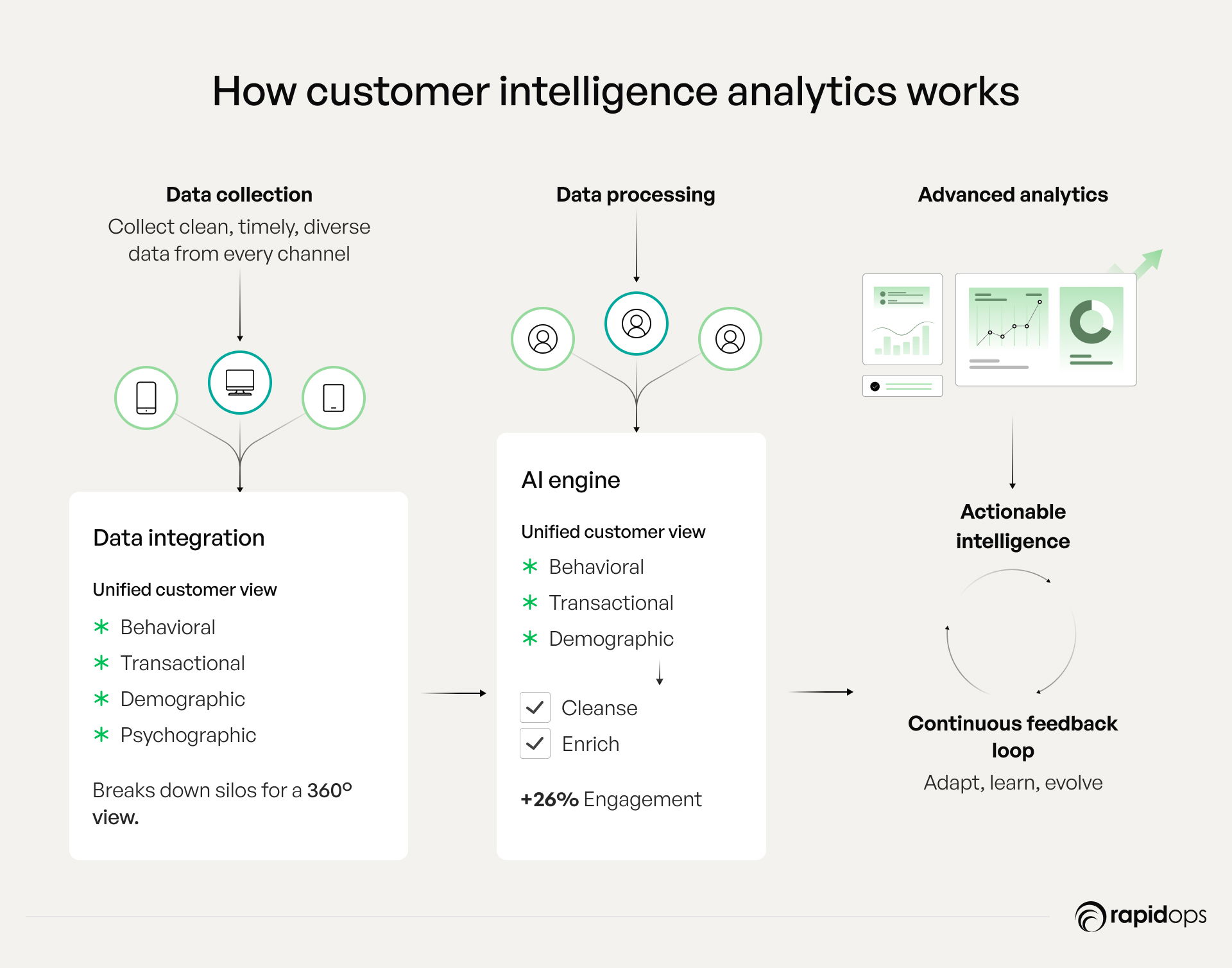
Customer intelligence analytics, defined
Customer intelligence analytics is the capability to transform fragmented customer data into real-time, predictive insights that drive precise, forward-looking decisions. It helps businesses not only understand what customers have done, but predict what they want, when they’ll want it, and how to deliver it seamlessly.
In today’s environment, where digital journeys span dozens of touchpoints and customer expectations evolve in days, not quarters, traditional analytics can’t keep pace. Leaders now need adaptive systems that detect micro-signals in real time and act on them before opportunities are lost.
Think of it this way: if data is your map, customer intelligence is your live GPS—constantly recalibrating based on traffic, detours, and destination: customer value.
In the modern era, where relevance is fleeting and competition is relentless, this level of intelligence isn’t optional. It’s the engine behind smarter personalization, faster pivots, and sustained loyalty.
How it works: The data-to-intelligence flow simplified
In the modern era, businesses need to turn raw customer data into actionable insights that drive decisions, enhance experiences, and maintain a competitive edge. The data-to-intelligence flow is the key to achieving this, transforming fragmented data into a unified, real-time understanding of customer behavior.
Here's how the process works:
Step 1: Data collection, gathering the right information
The first step is collecting diverse data from a variety of touchpoints, online interactions, transactions, website activity, social media, and more. Clean, accurate, and timely data is essential for success. Without high-quality data, businesses risk making decisions based on unreliable insights.
Step 2: Data integration, Unifying customer data
The next step is integrating these data sources to create a 360-degree customer view. Breaking down data silos is crucial by connecting behavioral, transactional, demographic, and psychographic data, businesses gain a complete, unified understanding of each customer, enabling them to make informed, real-time decisions.
Step 3: Data processing, preparing data for analysis
To ensure the accuracy of insights, data must be cleaned and enriched. Data cleansing ensures the information is free of errors and incomplete entries, while data enrichment combines both internal and external data to create richer customer profiles, adding depth and context to insights.
Step 4: Advanced analytics, extracting meaningful insights
With the data prepared, advanced analytics comes into play. Predictive analytics, powered by AI and machine learning, enables businesses to identify trends, detect patterns, and anticipate future customer behavior. This provides companies with a competitive advantage by allowing them to act on data-driven insights before opportunities slip by.
Step 5: Actionable intelligence, turning insights into strategy
The goal of the data-to-intelligence flow is to drive real-time decision-making. Once insights are derived, businesses can immediately personalize customer experiences, automate interactions, and optimize the customer journey. This step ensures that every action taken is relevant and timely, boosting engagement and satisfaction.
Step 6: Continuous feedback loop, improving over time
To remain agile and responsive, the data-to-intelligence flow incorporates a continuous feedback loop. By tracking key performance indicators (KPIs), businesses can measure the success of their strategies and refine their approaches based on real-time feedback. This iterative improvement ensures that businesses stay aligned with customer needs and preferences over time.
The power of the data-to-intelligence flow for business success
This streamlined process empowers businesses to make smarter decisions, increase customer satisfaction, and gain a competitive edge. By turning raw data into actionable insights, businesses can stay ahead of the competition, deliver personalized experiences, and adapt quickly to market shifts.
The data-to-intelligence flow is not just about collecting information, it’s about creating the foundation for informed, real-time actions that drive customer loyalty and business growth.
Why It’s more than just customer analytics
Traditional customer analytics is descriptive, siloed, and retrospective, offering insights into past behaviors without offering the real-time, actionable foresight needed for modern decision-making. These systems measure what has happened but don't connect the dots across the broader customer journey.
Customer intelligence analytics, on the other hand, is integrated, real-time, and strategic. It pulls together data from every touchpoint, website, app, in-store, social media, creating a unified, dynamic view of the customer. This integration reveals hidden connections between behaviors, enabling businesses to act quickly and strategically.
Customer intelligence analytics transforms data into a comprehensive, strategic asset, empowering businesses to drive personalized, timely actions across all customer touchpoints and remain agile in a fast-paced, competitive environment.
How it’s different from business intelligence
Business intelligence (BI) focuses on broad, organization-wide metrics and dashboards, providing insights into overall performance, trends, and operational health. It helps decision-makers track KPIs and understand past outcomes at an aggregate level.
Customer intelligence (CI), however, is customer-centric, designed to analyze individual behaviors and interactions. It provides real-time insights into customer preferences, needs, and intentions, enabling businesses to deliver personalized experiences and build lasting customer loyalty. While BI enhances internal operations, CI is critical for driving customer engagement and fostering growth by aligning strategies with real-time customer needs.
This distinction underscores why customer intelligence analytics is essential for businesses aiming to remain relevant and responsive in a customer-driven market.
Unified intelligence: The engine behind customer intelligence analytics
At the core of Customer intelligence analytics is the concept of unified intelligence, a sophisticated approach that integrates a variety of data types to create a comprehensive, real-time understanding of customer behavior. Unlike traditional systems that rely on isolated data sources, unified intelligence blends behavioral, transactional, demographic, and psychographic data, forming a richer, multidimensional view of the customer.
- Behavioral data reveals how customers interact with products or services, giving insights into intent and preferences.
- Transactional data provides concrete information on purchasing patterns, including frequency and value of purchases.
- Demographic data offers context around age, location, and income, which helps segment the customer base.
- Psychographic data goes deeper, providing insights into customer values, interests, and lifestyles, revealing what drives decisions at a personal level.
The power of this unified intelligence lies in its ability to connect dots across these diverse data streams, enabling advanced capabilities such as hyper-personalization, predictive analytics, and dynamic decision-making.
By synthesizing data in real time, businesses can adapt their strategies on the fly, anticipating customer needs and crafting individualized experiences that foster stronger relationships and drive long-term value.
Core capabilities: What customer intelligence analytics enables
In a world flooded with data, the real challenge isn’t just having information, it’s knowing how to act on it. Customer Intelligence Analytics allows you to move beyond hindsight and gain the clarity needed to make predictive decisions that impact your bottom line.
Imagine being able to foresee a customer’s next move, identify risks before they escalate, and uncover opportunities that were previously hidden in your data. This is the power that Customer intelligence analytics puts at your fingertips, helping you not just react to your market, but anticipate it, and position your business for sustained growth and success.
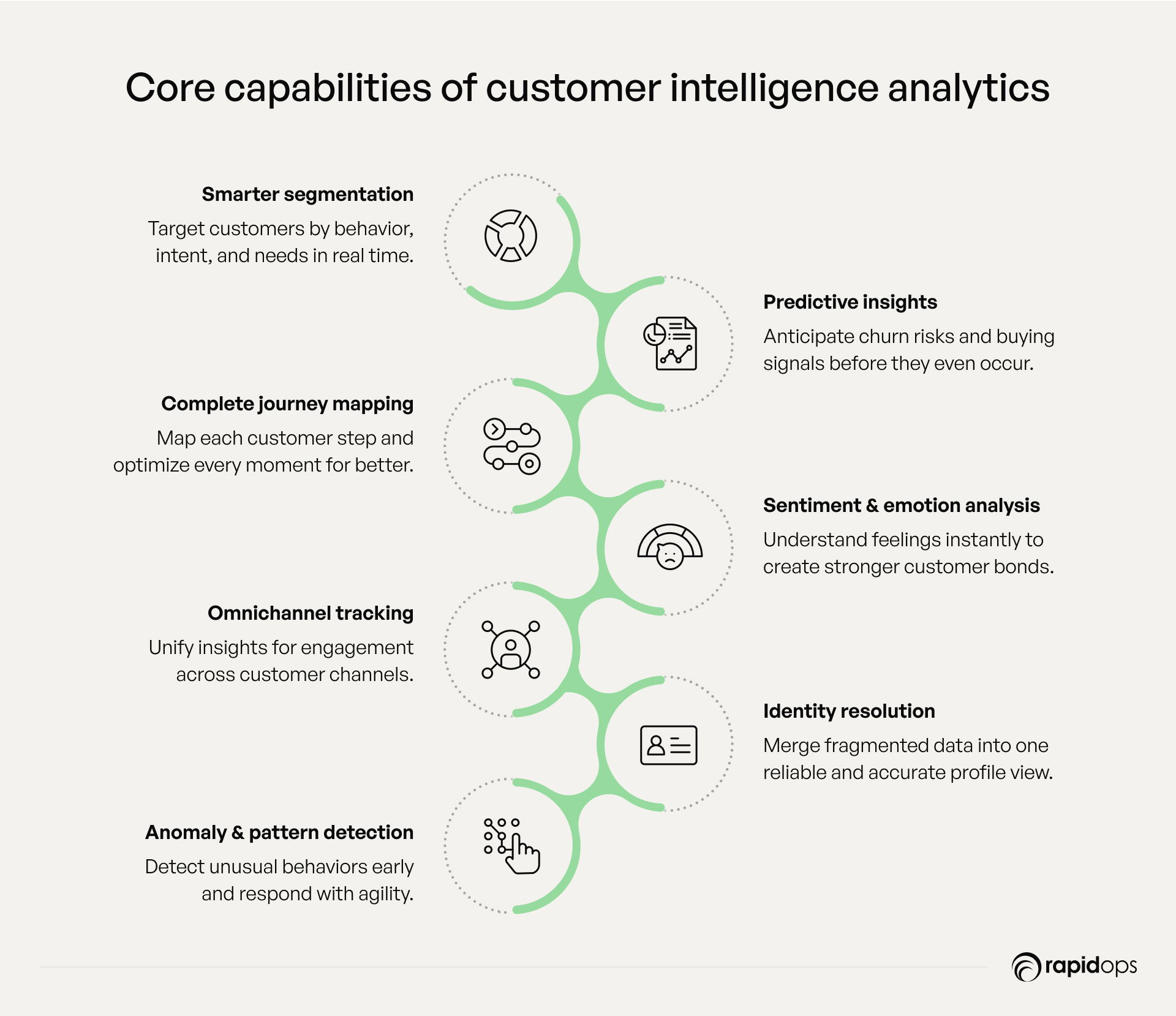
1. Advanced customer segmentation
Customer segmentation has traditionally been a cornerstone of marketing strategies. But with Customer Intelligence Analytics, segmentation goes far beyond basic demographics. By analyzing behavioral, transactional, and psychographic data, CI Analytics enables businesses to create highly refined customer profiles, segmenting audiences by their intentions, needs, and propensities to act.
This granular level of understanding allows for dynamic targeting, adapting in real-time to changing customer behaviors and preferences.
It goes beyond static categories, allowing businesses to engage with customers on an individual level, offering relevant content, products, and services that align with their current state of mind and needs.
2. Predictive customer insights
What if you could predict when a customer is likely to churn, or when they are most likely to make a purchase? With predictive analytics, Customer Intelligence Analytics uncovers not only historical trends but also future outcomes.
By analyzing large sets of data, customer intelligence analytics identifies signals that suggest a customer’s potential behavior, whether that’s a shift in purchasing habits, a risk of churn, or an increase in loyalty. It empowers businesses to take proactive actions, intervening before issues like churn arise or capitalizing on future opportunities for cross-selling and upselling.
The result? Businesses can make decisions with foresight, rather than hindsight, reducing uncertainty and enhancing customer retention and lifetime value.
3. Customer journey mapping
The customer journey has become increasingly complex, spanning a wide range of touchpoints websites, apps, social media, and in-store interactions. Customer Intelligence Analytics gives businesses the ability to map the entire journey, from discovery to purchase and beyond.
This capability identifies friction points that may cause customers to drop off, as well as key moments of truth where positive experiences can strengthen the relationship. By understanding the full customer experience, businesses can tailor their strategies across each stage of the journey, ensuring they are engaging customers at the right moment, in the right way.
The result is an optimized, frictionless journey that leads to higher conversion rates and more loyal customers.
4. Sentiment and emotion analysis
Understanding how customers feel about a brand, product, or service is critical in today’s emotional, experience-driven marketplace. Customer Intelligence Analytics incorporates sentiment analysis, parsing text, voice, and social media data to assess customer emotions.
This capability goes beyond basic feedback surveys, analyzing unstructured data to quantify sentiments and identify emotional triggers that drive customer actions. By interpreting positive, negative, and neutral sentiments in real time, businesses can respond more effectively to customer needs, fine-tuning products, services, and marketing campaigns to align with customer emotions.
In an age where customer loyalty is increasingly tied to personal experiences, emotion-driven insights can be the differentiator between a customer who stays and one who walks away.
5. Omnichannel behavioral tracking
Today’s customers interact with brands across multiple channels, often simultaneously. The challenge for businesses is understanding these interactions in context and integrating them into a cohesive view of the customer.
Customer intelligence analytics solves this by unifying data from websites, mobile apps, social media, call centers, and in-store visits to build a comprehensive, 360-degree view of each customer.
By tracking cross-channel behaviors, businesses can better understand how customers engage with them across different touchpoints, providing deeper insights into customer preferences and patterns. This holistic view enables brands to optimize customer experiences across channels, ensuring consistency and relevance at every touchpoint.
6. Identity resolution and profile unification
In the age of multichannel engagement, customer data is often fragmented, scattered across various systems and platforms. A major challenge for businesses is creating a single, unified customer profile that consolidates data from multiple sources.
Customer intelligence analytics solves this with identity resolution, merging disparate customer records into a single, accurate profile. This unification process involves connecting multiple customer identifiers (such as email addresses, phone numbers, or social media accounts) to create a comprehensive picture of each customer’s journey and preferences. The result is a holistic view that allows businesses to deliver personalized, seamless experiences across all touchpoints, regardless of how customers interact with them.
7. Anomaly and pattern detection
Customer behavior is rarely predictable in the traditional sense, making it difficult to anticipate potential disruptions. CI Analytics continuously monitors customer data to identify anomalies or patterns that may indicate a shift in customer behavior.
For example, a sudden increase in website traffic, a spike in negative sentiment, or a drop in engagement can signal emerging trends that require immediate attention. These patterns, detected early, allow businesses to take timely action, adjusting their strategies, messaging, or offerings to align with changing customer preferences or market conditions. With real-time insights, businesses can adapt quickly to unexpected shifts in behavior, reducing the risk of missed opportunities or negative outcomes.
Why businesses need customer intelligence analytics in this modern era
In today’s data-rich landscape, customer intelligence analytics stands out by transforming fragmented data into clear, actionable insights. It enables businesses to act swiftly and strategically, driving revenue growth, optimizing marketing efforts, and enhancing customer loyalty, all while fostering data-driven decision-making.
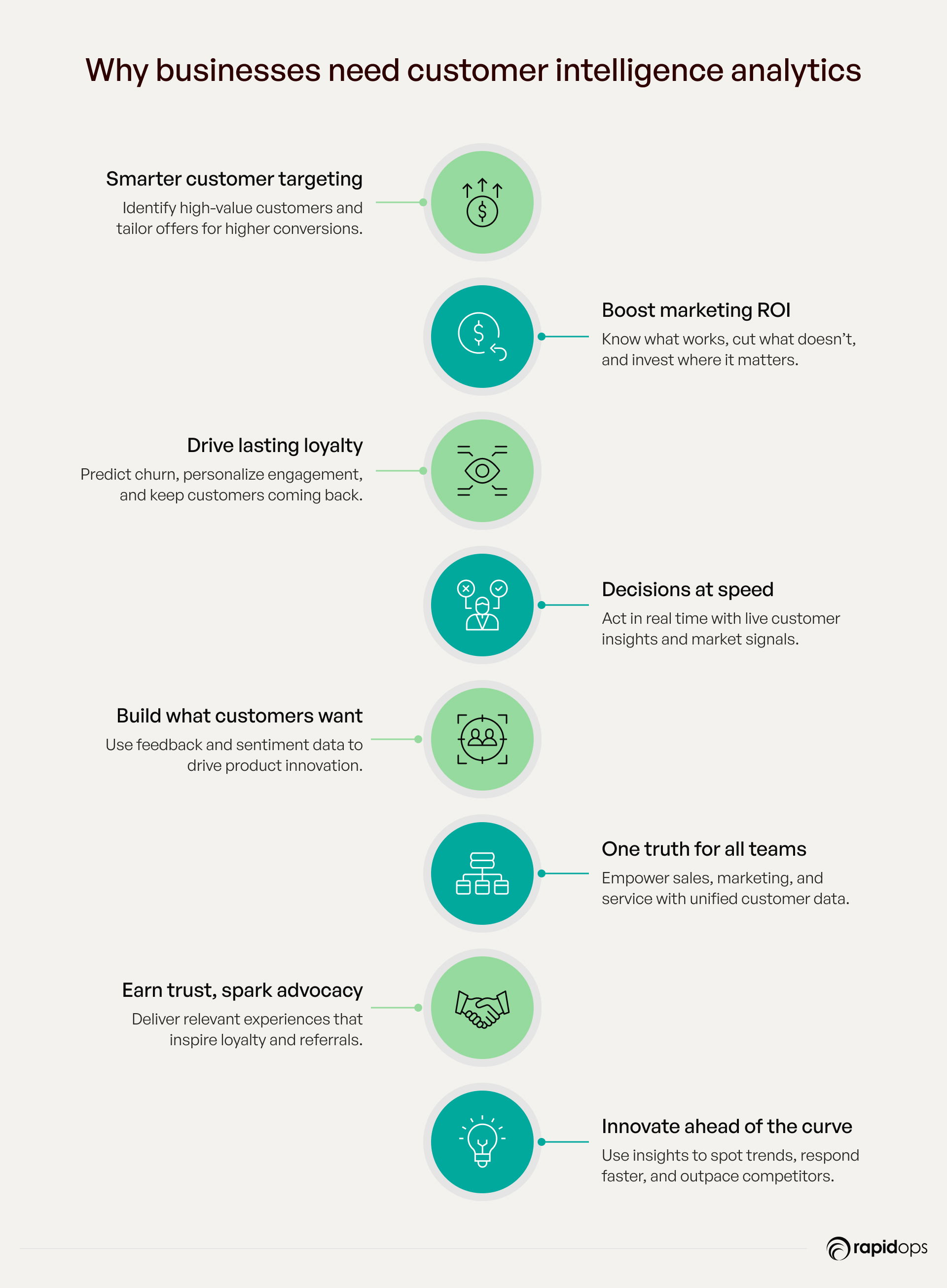
1. Driving revenue growth through precision targeting
Customer intelligence analytics enables businesses to identify high-value customer segments with exceptional precision. By analyzing behaviors, preferences, and purchase patterns, businesses can create highly targeted campaigns that speak directly to the needs of each segment.
This level of precision drives higher conversion rates, improves customer acquisition, and ultimately boosts revenue growth. The ability to personalize offerings ensures that businesses are delivering the right product to the right customer at the right time.
2. Optimizing marketing spend for maximum ROI
Marketing budgets are under constant scrutiny, with pressure to deliver results. Customer intelligence analytics empowers businesses to allocate marketing spend more efficiently by identifying which channels and strategies yield the highest return on investment.
By understanding the effectiveness of different touchpoints, businesses can optimize campaigns in real-time, cutting waste and focusing efforts on high-performing channels. This not only enhances ROI but also ensures that marketing spend is directly aligned with customer behavior and preferences.
3. Enhancing customer retention and loyalty
In today’s competitive environment, retaining existing customers is as critical, if not more so, as acquiring new ones. Customer intelligence analytics provides deep insights into customer behavior and sentiment, allowing businesses to identify potential churn risks early.
By recognizing early warning signs, companies can take proactive steps to address issues before they lead to customer departure.
Additionally, personalized engagement and tailored experiences, driven by real-time insights, help foster long-term customer loyalty and satisfaction, which are key to sustained business success.
4. Accelerating decision-making with real-time insights
The speed of business today demands that decisions be made quickly and accurately. Traditional data analysis methods can’t keep up with the rapid pace of change in customer preferences and market conditions. Customer intelligence analytics enables businesses to make data-driven decisions in real-time.
With access to up-to-the-minute insights on customer behavior, market trends, and emerging opportunities, decision-makers can act swiftly to capitalize on opportunities, mitigate risks, and optimize strategies. This agility is essential for staying competitive in a dynamic marketplace.
5. Innovating products and services based on customer feedback
Customer intelligence analytics provides a direct line to customer feedback and sentiment, which is invaluable for product and service innovation.
By continuously monitoring customer preferences, pain points, and desires, businesses can develop new products or refine existing offerings to better align with market demand. Customer intelligence analytics ensures that product development is data-driven, helping businesses create offerings that are more likely to resonate with customers and succeed in the market.
6. Enhancing operational efficiency across departments
The integration of customer intelligence analytics across different business functions enables greater operational efficiency. By providing a unified view of customer data, departments such as sales, marketing, customer service, and product development can collaborate more effectively.
The shared insights foster alignment across teams, ensuring that every department is working toward common objectives. Streamlined operations, improved coordination, and data-driven strategies all contribute to enhanced productivity and cost efficiency.
7. Strengthening brand trust and customer advocacy
In an age where customer trust is paramount, Customer intelligence analytics plays a key role in building and maintaining strong relationships with customers. By understanding customer needs and providing personalized, relevant experiences, businesses demonstrate a commitment to their customers’ satisfaction. As customers experience more tailored, meaningful interactions, their loyalty deepens, leading to stronger brand trust. Loyal customers are more likely to become advocates, sharing positive experiences with others and driving organic growth.
8. Enabling data-driven innovation and competitive advantage
In a world driven by data, businesses that leverage customer insights effectively gain a significant competitive advantage. Customer intelligence analytics helps companies stay ahead of market trends by identifying shifts in customer behavior, emerging preferences, and unmet needs.
This insight enables businesses to innovate proactively, offering new products, services, and solutions that anticipate customer demands before competitors do. By continuously evolving based on customer intelligence, businesses can position themselves as market leaders, outpacing rivals and establishing a distinct, data-driven competitive edge.
Key technologies powering customer intelligence analytics today
In 2025, Customer intelligence analytics is no longer just about capturing and visualizing data, it's about engineering intelligence at scale. This requires a sophisticated ecosystem of interconnected technologies that work in harmony to collect, interpret, and act on customer signals in real-time. Here’s an in-depth look at the foundational technologies making this possible.
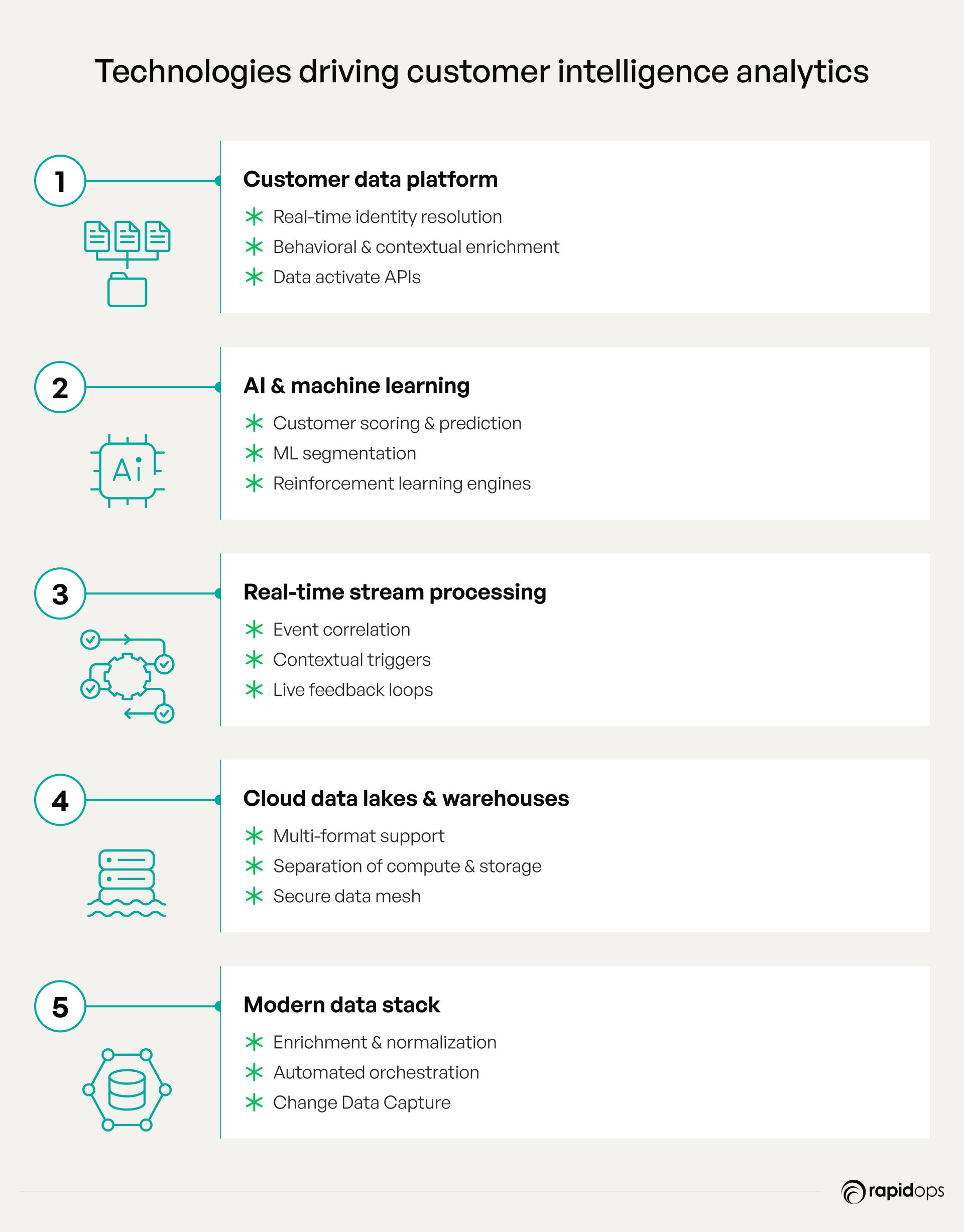
1. Customer data platforms unify data across channels
In 2025, CDPs serve as the single source of truth for all customer-related data. Unlike traditional CRM systems that are often fragmented and channel-specific, CDPs are built to ingest and unify customer signals across online, offline, and third-party touchpoints in real time.
How CDPs power customer intelligence analytics:
- Real-time identity resolution: Advanced CDPs now incorporate probabilistic and deterministic matching to reconcile customer identities across channels, devices, and data sources, creating a persistent unified profile.
- Behavioral and contextual layering: Modern platforms enrich profiles with behavioral and contextual metadata, what customers are doing, where, and under what circumstances.
- Data activation APIs: CDPs expose clean, real-time data to downstream systems like analytics platforms, AI engines, and decisioning tools, enabling continuous insight delivery and campaign execution.
2. AI and ML drive predictive insights for customer behavior
AI and ML technologies form the analytical core of customer intelligence, making sense of massive datasets that are impossible to analyze manually. These systems do more than generate insights, they proactively drive business actions.
How AI/ML powers customer intelligence analytics:
- Customer scoring and prediction: From churn probability to lifetime value (LTV) and intent to purchase, ML models dynamically score customers to predict behavior.
- Segmentation at scale: ML-driven clustering algorithms identify nuanced micro-segments based on hundreds of signals, far beyond what traditional BI tools can support.
- Next-best action engines: Reinforcement learning models suggest optimal offers, messages, or interactions per customer, personalized down to the moment.
- Generative AI for insight synthesis: Some organizations are using generative AI to summarize complex behavioral patterns or generate hypotheses from customer data.
3. Real-time tools deliver personalized experiences instantly
Customer intelligence analytics demands sub-second responsiveness. Stream processing tools are the technologies that ingest, filter, and react to customer behavior in motion.
How stream processing powers customer intelligence analytics:
- Event correlation at speed: Technologies like Apache Kafka, Pulsar, and Flink correlate millions of events in real time, identifying meaningful patterns like drop-off sequences or multi-touch journeys.
- Contextual triggering: These platforms detect specific conditions (e.g., price sensitivity signals, cart abandonment) and route that intelligence to personalization engines or CDPs instantly.
- Real-time feedback loops: They power the feedback loop between insight and action, ensuring that recommendations and decisions are updated as customer behavior evolves, without delay.
4. Cloud data lakes and warehouses enable scalable analytics
As data volume, velocity, and variety grow, CI analytics platforms rely on modern data lakes and warehouses to store and compute insights at scale.
How they power customer intelligence analytics:
- Multi-format data management: Cloud data lakes (e.g., Delta Lake, AWS Lake Formation) allow seamless ingestion and retrieval of structured, semi-structured, and unstructured data, critical for holistic customer views.
- Separation of storage and compute: Cloud-native warehouses like Snowflake and BigQuery support high concurrency and scalability, allowing multiple analytics engines to run in parallel.
- Data mesh & sharing models: These architectures support cross-functional use cases, enabling secure data sharing across departments without compromising compliance or latency.
5. Modern data stack integration connects tools for seamless flow
Data isn’t useful unless it’s accessible and analytics-ready. ETL (Extract-Transform-Load) and ELT (Extract-Load-Transform) tools ensure that raw data is continuously prepared, cleaned, and routed into analytical environments.
How they power customer intelligence analytics:
- Data normalization & enrichment: Modern tools like dbt, Fivetran, and Matillion help transform and enrich raw data, adding business context that analytics tools can interpret.
- Orchestrated workflows: Airflow and Prefect automate complex pipelines that span ingestion, validation, and transformation, ensuring reliable and fresh data feeds.
- Real-time data integration: With support for CDC (Change Data Capture), these tools enable low-latency updates to analytical models and dashboards.
6. Customer analytics platforms: Enabling data-driven decisions
Once data is processed and modeled, analytics platforms make it actionable, turning technical insight into business intelligence that can be used by marketers, product managers, and service teams.
How they power customer intelligence analytics:
- Self-service dashboards: Tools like Looker, Tableau, and ThoughtSpot allow non-technical users to explore customer data intuitively.
- Embedded analytics: Insight modules can be plugged directly into CRM, eCommerce, or customer service interfaces, putting intelligence where it’s needed most.
- Data modeling layers: These platforms offer semantic layers that translate raw fields into business concepts, making metrics easier to understand, interpret, and act upon.
The technologies powering customer intelligence analytics are transforming how businesses understand and engage with customers. By leveraging tools like CDPs, AI, real-time analytics, and cloud solutions, businesses can gain deeper insights, improve decisions, and deliver personalized experiences, driving growth and competitiveness.
Assessing and getting ready for customer intelligence analytics
As customer expectations shift, organizations must evolve to remain competitive. Customer intelligence analytics is crucial, but it requires a strategic approach, the right tools, and seamless alignment across teams. Here’s how to assess your readiness for customer intelligence analytics and what to prioritize in your journey.
Do you have unified customer data?
To fully leverage customer intelligence analytics, you must consolidate and unify your customer data across all touchpoints, web, mobile, CRM, and social media, into comprehensive, accessible customer profiles. Disconnected data can hinder decision-making and limit personalization, which is essential for acting on real-time insights.
Are you acting on real-time insights?
Customer behaviors are ever evolving, and timely decisions are critical. Customer Intelligence Analytics enables you to act on real-time insights, whether personalizing content or offering dynamic support, to maintain a competitive edge and deliver superior customer experiences. Unified, real-time data ensures responsiveness.
Are insights driving decisions across departments?
For customer intelligence analytics to drive transformation, it must impact every department, not just marketing. Insights should be shared across the organization, from sales to product development, ensuring that decisions are data-driven and customer-centric. This alignment leads to more coherent, impactful strategies.
Do you have the right mix of tools and talent?
Effective customer intelligence analytics demands the right combination of advanced tools and skilled talent. Integrate customer data platforms (CDPs), predictive analytics, and real-time engagement tools into your tech stack. Complement this with skilled data scientists and analysts who can turn insights into strategic actions, ensuring maximum value from your investments.
What to prioritize in your customer intelligence analytics journey
To implement customer intelligence analytics successfully, a structured approach is key. Here’s where to focus to ensure your journey delivers measurable impact.
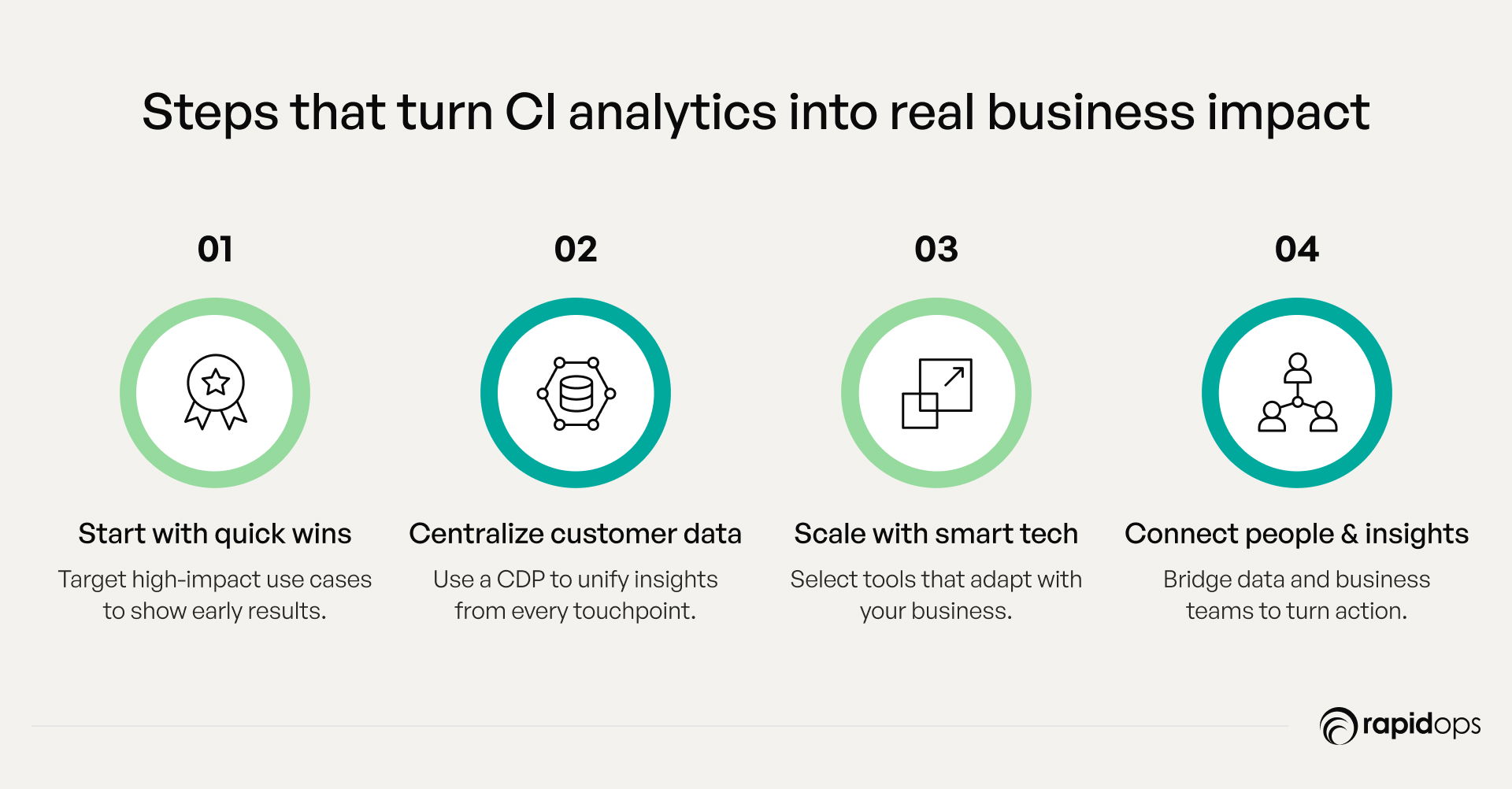
Start with your highest value use case
Identify the most impactful areas where customer intelligence analytics can deliver immediate results, such as reducing churn, enhancing personalization, or boosting retention. Prioritizing these high value use cases ensures a clear, actionable direction for your efforts.
Invest in unifying your data foundation
A solid, unified data foundation is critical to Customer Intelligence Analytics success. Implement a customer data platform (CDP) or integrated systems that consolidate customer data from all touchpoints. This unified approach allows for accurate, comprehensive insights, fueling more informed and targeted decision-making.
Choose a tech stack that scales with Your business model
Invest in scalable, cloud-based solutions that grow with your business. Integrating AI-driven analytics, machine learning, and automation tools enables real-time insights and future adaptability, ensuring your tech stack remains effective as your business evolves.
Bridge the gap between data teams and business stakeholders
For customer intelligence analytics to generate value, data insights must be seamlessly translated into actionable strategies across business teams. Cultivate a collaborative, data-driven culture where technical and business teams align priorities and leverage insights to drive tangible outcomes.
How a retailer leveraged customer intelligence to drive impact
Retail: Macy’s, a leading retail giant, used customer intelligence analytics to enhance its personalization efforts. By analyzing customer shopping behavior and leveraging machine learning models, Macy’s was able to predict individual customer preferences and create tailored product recommendations.
This approach improved customer engagement, increasing their conversion rates by 20% and boosting average order value by 15%. Moreover, the retailer used CI Analytics to identify high-risk churn customers and sent personalized re-engagement offers, helping to retain 10% more customers compared to previous years.
Turning customer data into strategic clarity
As a business leader, you already know the challenge isn't a lack of data; it's the lack of alignment, clarity, and speed needed to act on it. In a landscape where every decision impact growth, fragmented insights slow you down, and disconnected dashboards cloud the bigger picture.
Customer Intelligence Analytics offers more than just understanding customer behavior; it enables you to anticipate it. It equips you to shift from reactive decisions to proactive strategies, helping you convert complexity into a clear, data-driven direction that drives measurable outcomes.
When customer intelligence analytics is integrated into your business model, it dissolves silos and unlocks precision. Marketing is becoming timely and relevant. Sales engage with purpose. Product teams prioritize what matters most. You move beyond the noise to the signals that shape innovation, accelerate growth, and deliver sustained value.
At Rapidops, we don't just bring tools; we bring partnerships. We work shoulder-to-shoulder with leaders like you to build intelligence frameworks that align with your vision, scale with your operations, and create a foundation for confident decision-making across the enterprise.
If you're ready to turn your customer data into a competitive advantage, we're here to help. Book a free consultation with one of our experts, and let's explore how we can translate your data into clarity, momentum, and long-term impact.

Rahul Chaudhary
Content Writer
With 5 years of experience in AI, software, and digital transformation, I’m passionate about making complex concepts easy to understand and apply. I create content that speaks to business leaders, offering practical, data-driven solutions that help you tackle real challenges and make informed decisions that drive growth.
What’s Inside
- Customer intelligence analytics: Beyond traditional analytics
- Core capabilities: What customer intelligence analytics enables
- Why businesses need customer intelligence analytics in this modern era
- Key technologies powering customer intelligence analytics today
- Assessing and getting ready for customer intelligence analytics
- How a retailer leveraged customer intelligence to drive impact
- Turning customer data into strategic clarity

Let’s build the next big thing!
Share your ideas and vision with us to explore your digital opportunities
Similar Stories
- Transformation
- undefined Mins
- March 2022

- Analytics
- undefined Mins
- July 2019


Receive articles like this in your mailbox
Sign up to get weekly insights & inspiration in your inbox.

